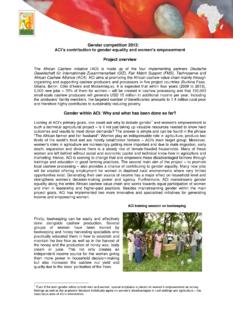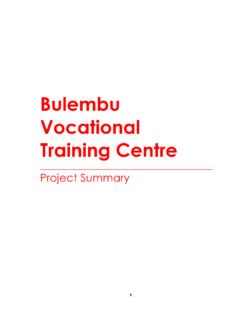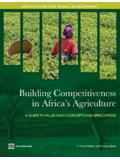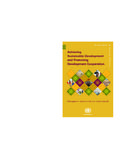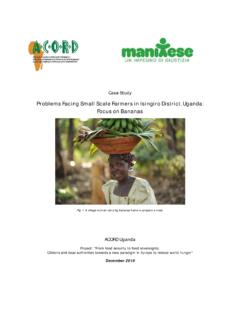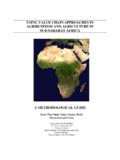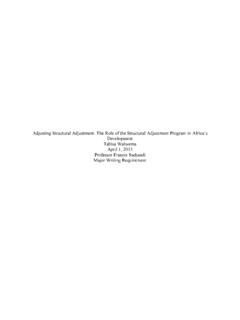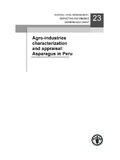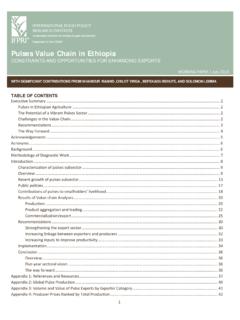Transcription of Analysis of the Cashew Value Chain in Senegal and …
1 Analysis of the Cashew Value Chain in Senegal and The Gambia African Cashew initiative Published by: Deuts che Gesel lsc haft f r Internati onal e Zus ammenarbeit (GIZ) GmbH Internati onal Foundati ons Postfach 5180, 65726 E sc hborn, Germany T + 49 61 96 79-1438 F + 49 61 96 79-80 1438 E Ulri os chell a@ gi I Place and date of publication: Germany,September 2011 Authors: Johannes Peters Peter Jaeger Gabriel Gomez Responsible editor: Rita W eidinger - E xecutiv e Di rector Afri can C as hew i nitiativ e (ACi ) 32, N ortei A babi o Street Airport Residenti al A rea Accra, GHANA T + 233 302 77 41 62 F + 233 302 77 13 63 Contact: Acknowledgement: This stud y has been impl emented as part of the Afric an C as hew i nitiativ e (ACi ), a proj ec t j ointl y financed by v ari ous private c ompanies, the Federal German Mi nistry for Ec onomic Cooperati on and D ev el opm ent and the Bi ll & Meli nda Gates Foundation.
2 ACi is impl emented by the A fri can Cashew Alli ance (AC A), the German D ev el opm ent C ooperati on GIZ, as a lead agenc y as well as Fai rMatc hSupport and T ec hnos erve. This report is bas ed on res earc h funded by the Bill & Meli nda Gates Foundati on. The fi ndi ngs and concl usi ons c ontained wi thi n are those of the authors and do not nec ess aril y refl ec t positi ons or polici es of the Bill & Melinda Gates Foundati on. Design: creati ve republic // Thomas Maxeiner Vis ual Communic ati on,Frank furt am Mai n/Germany T 4969-915085-60 I reati Photos: GIZ/R di ger B ehrens ,Peter J aeger, Thorben K ruse & creativ e republi c, i Stock , S hutters tock and private sector partners African Cashew Initiative is funded by: Implemented by: In cooperation with: Analysis of the Cashew Value Chain in Senegal and The Gambia September 2011 4 Table of Contents Executive Summary.
3 6 1 Introduction .. 9 2 Analysis of the Cashew Value Chain in Senegal .. 10 Cashew Production .. 10 Cashew commercialisation .. 16 Cashew processing .. 18 National and International Programmes Supporting Cashew Value Chain .. 23 3 Analysis of the Cashew Value Chain in The Gambia .. 28 Cashew Production .. 28 Cashew Commercialisation .. 33 Cashew Processing in The Gambia .. 34 Support Organisations .. 35 4 Senegal and Gambia as a producing region .. 36 Smuggling .. 39 Quality Standards .. 39 Consumption .. 40 Exports and Competitiveness .. 41 Economics .. 42 Bilbliography .. 44 Abbreviations .. 45 Annex 1: Gambian Raw Cashewnut Balance Sheet .. 47 Annex 2: Processing budget .. 48 Annex 3: Regional Ports .. 49 Annex 4: Climate Data .. 51 Annex 5: Persons Met Senegal Cashew Mission (August September 2010) .. 53 Annex 6: Persons Met Gambia Cashew Mission (August September 2010).
4 54 Annex 7: Economic Metrics for Senegal and The Gambia . 55 Annex 8: Cashew Production Data for Senegal and The Gambia .. 56 Annex 9: Currencies .. 57 Annex 10: Possible Upgrading Strategy .. 58 Annex 11: Opportunities and Constraints .. 59 Annex 12: Proposal of Operational Upgrading Objectives .. 60 List of Figures Figure 1: Crop calendar for Senegal and The Gambia ..7 Figure : The Cashew Export Value Chain in Senegal ..10 Figure : Cashew Production in Senegal by Administrative Region ..11 Figure : Locations of Cashew growing ares in Senegal ..11 Figure : The Cashew processing Chain in Senegal ..19 Figure : The Cashew export Value Chain in The Gambia ..28 Figure : Areas relevant for Cashew production and Export in The Gambia ..29 Figure : Cashew producing areas in The Gambia ..29 Figure : Cashew production in West Africa ..36 Figure : The Cashew Value Chain in the Senegal , Gambia and Guinea Bissau region.
5 Data apply to 2010 ..38 Figure : Indian in-shell Cashew imports by principal Figure : Break-out of Values from Farmgate to FOB ..43 List of Tables Table : Estimates for the production, processing and availability for export of Cashew in Senegal and Gambia ..9 Table : Estimated Cashew Production in Senegal in Recent Years (in tonnes) ..12 Table : Plantation Size and Number of Trees by Zone ..13 Table : First Year of Harvest in Casamance ..14 Table : Planting methods in Casamance ..14 Table : Plantation practices before flowering ..15 Table : Main Production Problems ..16 Table : Distribution of how Cashew is harvested ..16 Table : Who collects nuts ..16 Table : Cashew Nut Drying ..16 Table : Mean Relative Yield per tree in Casamance by Zone ..17 Table : Mean Price of Cashew per Kilo in 2009 Season 18 Table : Summary of Cashew processing facilities currently operating in Senegal .
6 22 Table : The donor projects supporting the Cashew sector in Senegal ..23 Table : Protection of young Cashew trees with local material ..27 Table : Principal Agricultural Products of The Table : First Year of Harvest by Zone ..30 Table : Crop budget for Cashew production (plantation without intercrop) The Gambia 2010 in USD ..31 Table : Plantation Size and Number of Trees by Zone ..32 Table : Planting method in The Gambia ..32 5 Table : Sources of Planting Materials .. 32 Table : Distribution of plantation practices before flowering .. 33 Table : Main Production Problems .. 33 Table : How Cashew is harvested .. 33 Table : Who Collects nuts .. 33 Table : Cashew Nut Drying Times .. 33 Table : Mean Price of Cashew per Kilo in 2009 Season 34 Table : Mean Relative Yield (marketed kg/tree) in Senegal by Zone .. 34 Table : Active Cashew processing facilities in The Gambia.
7 35 Table : Global Raw Cashew Nut Production 2010 .. 37 Table : Nut quality parameters in various growing areas of Senegal , Gambia and Guinea Bissau (2010).. 39 6 Executive Summary Cashew nut processing and exports are relatively new to The Gambia and Senegal even though the Cashew plant has a relatively long history in Senegal . Already in the 1940s the tree was introduced by the colonial Senegalese government. Until the 1970s occasional plantings took place meant as a means of reforestation and soil stabilisation, and providing hedging for mangos and other crops, windbreaks for vegetables, fruit for juicing and fermentation, and firewood. With the war in Guinea Bissau starting many Cashew farmers fled to Southern Senegal brining Cashew seeds and experience in Cashew production to the region. Migration from the region brought the knowledge to The Gambia as well.
8 This knowledge transfer in combination with the demand from Cashew buyers displaced by the war in Guinea Bissau as well supported the commercialisation of the crop in the 1980s. Finally, in the 1990s significant volumes became available to attract buyers which brought about a further development of the sector. Nowadays, production has reached a level of around 26,000 tonnes in Senegal and 9,000 in the Gambia. In Senegal , most cashews are grown in Casamance. Here, Cashew growing can be found in the whole region. As one of very few sources of income for the rural population Cashew production is quite important in economic terms. Smaller production areas are located in the regions Fatick and Thies. Near the town Sokone in Fatick region a relative stable production of 500 1,000 tonnes takes place. In Tivaoune Department of Thies region another estimated 1,000tonnes of Cashew are produced.
9 In all three regions land is becoming scarce but there is clear enthusiasm for planting where possible. Overall, production is likely to increase in the medium term as new plantings mature. In The Gambia, production takes place on both sides of the River. On the Southern side production is concentrated around Brikama, 30 km south to Banjul. On the North Bank cultivation areas extend a considerable distance upstream. Overall, an estimated 20,000 hectares is under Cashew cultivation in the country. But estimations are rather difficult to make since intercropping is the prevailing planting style. Intercropping is typically done with maize, millet or groundnuts. Since Gambian trees are mostly less than 10 years old there is further potential for production to increase.
10 The Cashew harvest in Senegal and The Gambia comes at the end of the West African season. While there are no other harvests elsewhere in the World that compete at this time, the market tends to be well supplied. The evacuation and sale of the Ivoirien crop, the biggest in Africa, continues as the Senegal /Gambia crop is picked. Even though Senegalese and Gambian nuts are of higher quality (in terms of nut size and outturn1) such concurrence of volume in the market weighs on prices. Nationally, in both countries the Cashew harvest arrives when there is little other work to be done in the fields and when stored food runs short. Therefore, the revenue from Cashew can have significant implications for food security. Even though farmers knowledge on prices is limited their share in the FOB Value of the product lies at around 60 to 65% of the FOB Value and interviews indicate that Cashew is perceived to be more profitable than groundnuts.
